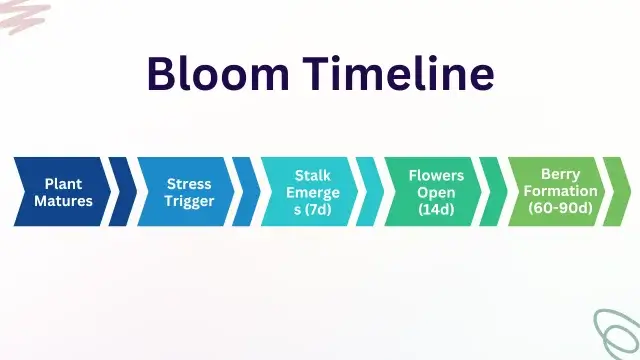Snake Plant Flower Guide: Why and How Snake Plants Bloom

Snake plants bloom rarely, triggered by mild stress (root-binding, drought) or maturity. Prioritize D. trifasciata or D. parva for best results. Provide 1,000–2,000 lux light, infrequent watering, and slight root-binding. All parts are toxic to pets—place high up. Flowers last 1–2 weeks with sticky nectar; hand-pollinate at dawn for rare berries. If stalks abort, increase light/temperature. Enjoy the bloom as a rare reward, not a care goal.
Snake plants (Dracaena trifasciata), known for their tough, sword-like leaves and low-maintenance care, are a staple in homes around the world. But every so often, a curious thing happens: a single flower stalk rises from the center, adorned with delicate blossoms.
This event is rare, which makes it even more special. So, what does it mean if your snake plant blooms? Is it a sign of perfect care, or something else entirely? Let’s uncover the truth behind this mysterious bloom.
1. What Is a Snake Plant Flower?
A snake plant flower grows on a long, thin stem that can be as tall as 3 feet.The blossoms themselves are small, tubular, and usually white or cream-colored with a light green tinge. Some people compare their appearance to honeysuckle.
The scent is subjective—many describe it as sweet and jasmine-like, but others find it grassy or even unpleasant. This variation is due to shifts in volatile terpenes that can change with plant stress; stress-induced blooms may produce stronger or even musky odors.
Clusters of these flowers open gradually along the stalk, and sticky nectar droplets are commonly seen. This nectar can stain surfaces and attract pests, so it’s wise to protect nearby furniture or flooring with a tray or paper towels during bloom.
Flowers are lovely but short-lived, typically lasting only 1 to 2 weeks..
2. Types and Varieties of Snake Plants That Bloom
Not all snake plants are equally likely to produce flowers, but several well-known varieties have been reported to bloom under the right conditions.
Most flowering reports come from mature, root-bound plants of standard green-leafed types, but some specialty varieties can also surprise you with blooms.
Snake Plant Blooming Varieties Table
| Variety | Bloom Frequency | Key Triggers |
|---|---|---|
| Dracaena trifasciata | High | Root-binding, bright light |
| Dracaena cylindrica (angolensis) | High | Drought stress, maturity |
| Dracaena parva (Kenya Hyacinth) | Very high | Seasonal dryness, slight neglect |
| Dracaena trifasciata ‘Laurentii’ | Low | Root-binding, age |
Not sure which type you have, or want to discover more? Explore different snake plant varieties to find the perfect fit for your home and increase your chances of seeing a bloom.
Rare Varieties Note:
Highly variegated cultivars (e.g., ‘Moonshine’) rarely bloom due to reduced chlorophyll. For blooms, prioritize solid-green varieties.
Also, the plant group called “snake plant” was moved from the Sansevieria group to the Dracaena group. Many resources and plant enthusiasts still use both names interchangeably.
If you’re hoping to see blooms, choosing a standard, mature variety and letting it become slightly root-bound may give you the best chance.
3. Why Do Snake Plants Flower?
Snake plants usually flower due to stress. When a mature snake plant experiences conditions like being root-bound, underwatered, or exposed to prolonged neglect, it may enter a reproductive mode to ensure survival.
This phenomenon is referred to as stress-induced flowering, which is common in many drought-tolerant plants. However, some plants bloom simply due to age and maturity without severe stress.
4. When and How Often Do Snake Plants Bloom?
Indoors, snake plant blooms are extremely rare. But when they do occur, they usually appear in late winter to early spring. Key facts include:
- Snake plants can bloom as early as 2 years old if healthy and root-bound, though maturity increases the likelihood.
- Most snake plants will bloom once in their lifetime, or very rarely thereafter.
- Environmental triggers and plant maturity play bigger roles than genetics.
Outdoor snake plants in USDA zones 9–11 are more likely to bloom during spring and summer. Plants in Mediterranean climates (dry summers, mild winters) bloom most reliably; high humidity and frequent rainfall can reduce bloom likelihood. In humid regions, place outdoor plants under eaves or in breezy spots to mimic dry-summer conditions.
If your plant hasn’t bloomed after 5+ years in optimal conditions, it may simply be genetically predisposed to focus on foliage growth – and that’s perfectly normal.

5. Conditions That Encourage Snake Plant Flowering
If you want to improve the odds of seeing a flower stalk rise, these conditions help:
- Light: Aim for bright, indirect light—specifically, 1,000–2,000 lux (about 100–200 foot-candles) for 6–8 hours daily.
Achieve this with:- East-facing window (1,000 lux at 3 ft distance)
- 15W LED grow light (2,000 lux at 12 inches)
Use a light meter app to verify light levels.
- Watering: Allow soil to dry completely between watering. Overwatering discourages blooming.
- Soil: Use a fast-draining mix for optimal drainage:
Combine 2 parts potting soil with 1 part perlite or pumice and 1 part coarse sand. - Temperature: Keep between 65–75°F (18–24°C). Avoid sudden cold drafts.
- Pot Size: Let the plant become slightly root-bound. Tight roots may signal the plant to reproduce.
To ensure your plant thrives and has the best chance to flower, follow our comprehensive snake plant care guide for tips on light, watering, and soil.
6. Step-by-Step Guide: How to Encourage Your Snake Plant to Flower
While there are no guarantees, here’s a practical, evidence-based method to improve your chances:
- Place in Bright Light: South or east-facing windows are ideal. If needed, use a grow light and make sure the light is between 1,000 and 2,000 lux.
- Water Sparingly: Only water when the soil is bone dry.
- Let It Be Root-Bound: Resist the urge to repot unless absolutely necessary.
- Maintain Healthy Stress: The goal is a balance—enough stress to trigger blooming, but not enough to harm the plant.
- Wait for Maturity: Plants as young as 2 years can bloom if conditions are right, but older plants are more likely.
- Outdoor Advantage: If you live in Mediterranean zones (USDA 9–11), outdoor placement in spring/summer increases your chances. High humidity may reduce blooms. In humid regions, place plants under eaves or in breezy spots to mimic dry-summer conditions.
Note: No scientific studies support the idea that stopping fertilizer encourages blooming. Over-stressing can lead to leaf damage without flowers.
7. What to Expect: The Flowering Process and Aftercare
Once the flower stalk appears:
- It will take a few days to fully grow and begin blooming.
- The flowers bloom one after another and typically remain open for up to two weeks.
- The fragrance is strongest at night, but may range from sweet to musky depending on plant stress and terpene content.
Aftercare Tips:
- Manage sticky nectar by protecting surfaces and cleaning up promptly to avoid stains or pests.
- Once blooming ends, cut the stalk at its base.
- Repot after flowering if the plant is severely root-bound—prolonged root stress can harm long-term health.
- Resume normal watering and light.
Flowering doesn’t harm the plant, but extended stress may, so be ready to return to a regular care routine afterward.
8. Troubleshooting Snake Plant Flowering
If your snake plant produces a flower stalk that aborts (fails to bloom or withers prematurely), try these steps:
- Increase light by 30% (move closer to a window or add a stronger grow light).
- Raise temperature above 70°F (21°C), especially at night.
- Trim damaged leaves to redirect the plant’s energy toward flowering.
These adjustments can help support successful blooms and prevent future flower loss. For readers experiencing issues like aborted flower stalks or leaf damage, our guide on common snake plant problems offers practical solutions.
9. Pet Safety and Toxicity
All parts of the snake plant, including its flowers, are toxic to pets due to the presence of saponins. If cats or dogs eat any part, they may experience nausea, vomiting, or diarrhea.
The sticky nectar may attract pets, increasing ingestion risk. To keep pets safe, place snake plants in hanging pots or on shelves at least 5 feet high and clean up any fallen flowers or nectar promptly.
10. Pollination and Seed Set
In the wild, snake plant flowers are pollinated by nocturnal moths (Baker 1961). Indoors, hand-pollination is possible: gently transfer pollen from one open flower to another using a soft brush, ideally in the early morning when flowers are most receptive.
Running a small fan nearby can help simulate a natural breeze, which may increase pollination success. If successful, small orange berries may form in 2–3 months.
Berries rarely yield viable seeds indoors. Seeds require outdoor conditions (70–85°F days, 55°F nights) to germinate—nearly impossible to replicate indoors. The berries are not edible and should be removed if pets or children are present.
If you’re curious about expanding your collection after a rare bloom, learn more about propagating your snake plant using simple methods.
11. Myths and Misconceptions About Snake Plant Blooms
| Myth | Fact |
|---|---|
| Blooming means your plant is perfectly happy. | It likely means your plant is mature and possibly a little stressed. |
| The bloom is harmful to the plant. | Not at all. The plant continues life as usual unless stress is severe. |
| Snake plant flowers are extremely rare. | They’re uncommon, but not impossible. Right conditions and time help. |
Final Thoughts: Appreciating the Snake Plant’s Rare Bloom
A flowering snake plant is a quiet miracle. Whether it blooms once in a lifetime or never at all, it remains a symbol of resilience, patience, and the subtle magic of houseplants.
Instead of chasing the bloom, focus on long-term health. If the bloom comes? Consider it a reward for years of quiet growth.
Beyond their unique flowers, snake plants offer a range of benefits—discover what snake plants do for your home and why they’re so popular.
References
